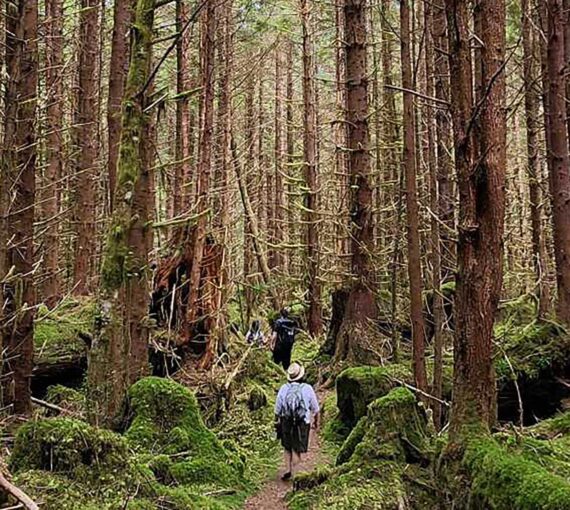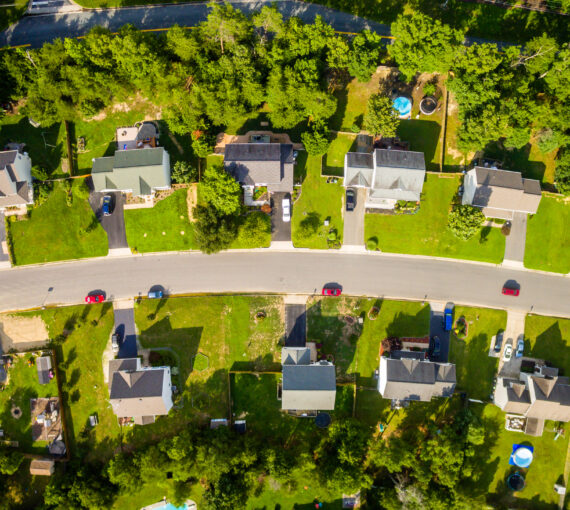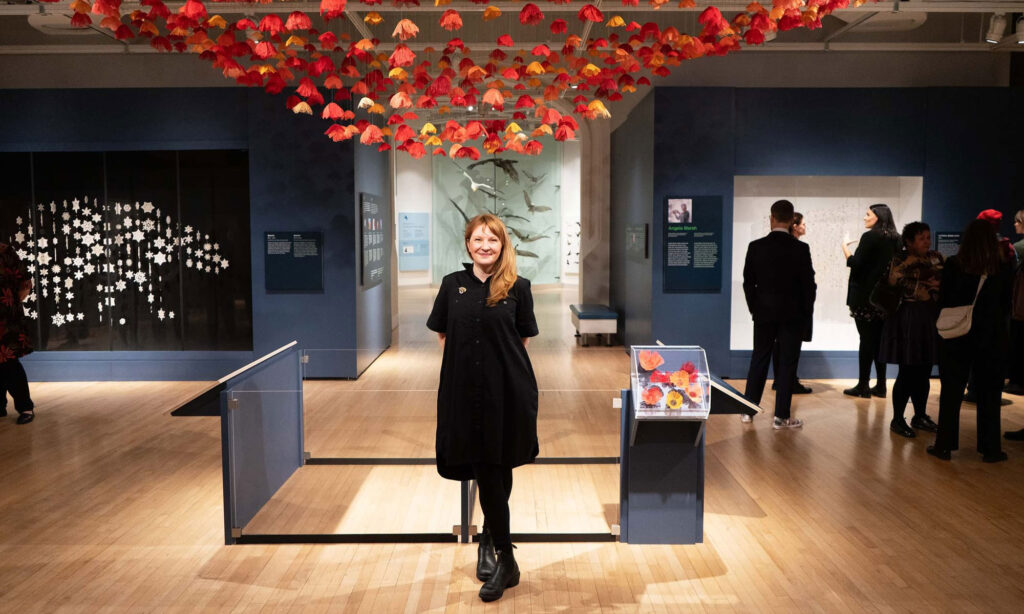
Amanda McCavour with her piece at the Canadian Museum of Nature's Rewilding exhibit. (Photo: D. Steed)
A new exhibit in partnership with the David Suzuki Foundation and Rewilding Magazine showcases artistic expressions of rewilding.
The first thing you’ll notice at the Canadian Museum of Nature’s new Rewilding exhibit is an almost impossibly vibrant floral display suspended from the ceiling. That’s Amanda McCavour’s work, and it’s hard to miss. More than 500 poppies take centre stage, delicately embroidered on dissolvable fabric. Though the flowers look fragile, each line of thread (and there are many) contributes to their strength. It might be the most perfect allegory for rewilding: Nature, like her poppies, is more resilient with each individual effort.
This stunning work is just one of 13 currently on display at the Ottawa, Ontario, museum – and you’ll eventually find your eyes equally drawn to the work of the other 12 participating artists, many of them winners of the David Suzuki Foundation’s inaugural Rewilding Arts Prize. Each makes you think: this is just the beginning of what we could collectively accomplish.
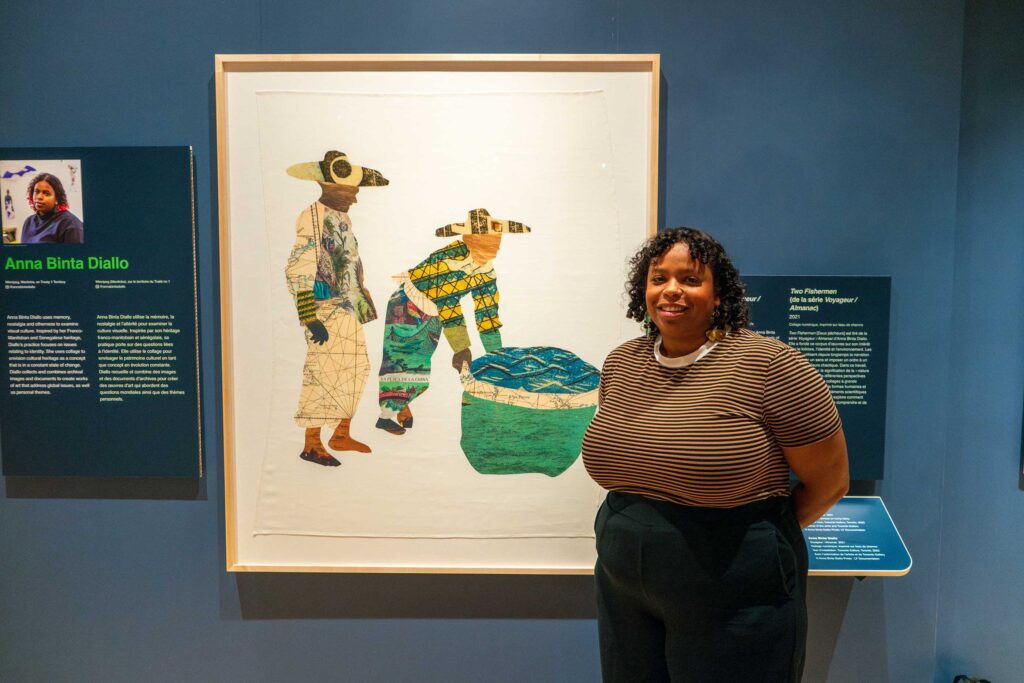
Participating artist Anna Binta Diallo. (Photo: D. Steed)
Jode Roberts, manager of the Rewilding Communities program at the David Suzuki Foundation, thinks visitors might be surprised by just how much complexity there is to the exhibit. “People might not expect to find such a dynamic mix of ecological, cultural, and artistic perspectives under one roof,” he says. He feels the exhibit is an opportunity to reawaken people’s connection to nature.
That’s thanks to the artists, each of whom approached themes of nature and rewilding in their own way. But it’s with a collective energy that the exhibit came together. In this spirit, throughout the year, interactive components will be offered for museum visitors, starting with an opportunity to craft their own tapestry à la Angela Marsh. Marsh uses fragments of wild plants found in abandoned urban lots and weaves them through bubble-wrap with painstaking detail. Don’t worry: the DIY version offered to visitors won’t take as long to complete.
“People might not expect to find such a dynamic mix of ecological, cultural, and artistic perspectives under one roof,” says Jode Roberts, manager of the Rewilding Communities program, David Suzuki Foundation.
Artist Xecê Khadija Baker might be the most inspiring when it comes to taking action in your own neighbourhood. She explores what it means to belong and feel at home in her 22-minute live performance, Performing Community Garden. As a Syrian immigrant, Baker says that gardening is what brought her community, and she set out to share that with others in a thought-provoking way.
Care is a recurring theme of the exhibit, as evidenced by the detailed nature sketches and colourful paintings contributed by Hashveenah Manoharan. They’re part of her “slow walk” series, which was very intentionally named with inspiration from the queen of nature poetry, Mary Oliver. Manoharan sees a slow walk as the simplest way we can all start to pay attention to and respect and care for nature. She uses the example of snakes, which (like many people) she used to fear. “I had no interest in overcoming [my] fear of snakes until I started working with and living among them,” she says. “They are emblematic of what attentiveness can do for our relationship to nature: once I started to seek them, I was able to appreciate them, and thus emboldened to work to protect them. This procedural advancement from attentiveness to respect to care is a powerful pipeline – one we all have the capacity to undertake, beginning with a slow walk.”
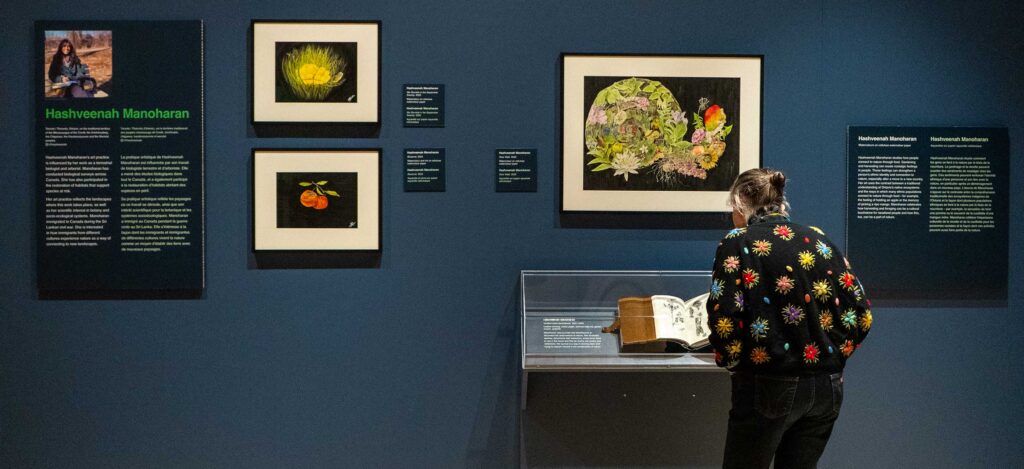
Scenes from the exhibit. A visitor examines a sketchbook by Hashveenah Manoharan. (Photo: D. Steed)
Another thing many people fear – or at least avoid – is insects. But Cole Swanson wants us to learn to appreciate them. He meticulously collected 280 household insect specimens and gilded them with 24-carat gold leaf, in the process taking something that’s often dismissed or derided and showing just how worthy it is of our care and attention.
The exhibit, which runs from October 11, 2024 to September 8, 2025, was even built sustainably. Museum staff used a modular wall system constructed from recycled materials, reused display cases and AV equipment from previous exhibitions, and did fabrication and metalwork onsite to reduce transportation emissions.
“This exhibition is an opportunity to deepen our understanding and inspire action for a sustainable future,” says Danika Goosney, President and CEO of the Canadian Museum of Nature.
“This exhibition is an opportunity to deepen our understanding and inspire action for a sustainable future,” says Danika Goosney, President and CEO of the Canadian Museum of Nature. And that’s exactly what the museum tries to do as well. Their outdoor plaza is even home to a number of native species that offer a sustainable source of food for the live ants, beetles and walking sticks in the Bugs Alive Gallery.
For anyone looking to live more sustainably and begin their own rewilding journey, perhaps the best place to begin is with a little inspiration from the exhibit. After all, encouraging people to become involved in rewilding in a hands-on way is exactly what its creators hope to accomplish. Rewilding doesn’t happen in a vacuum – care and community are at its core. “By witnessing these artistic expressions of rewilding, my hope is that people will leave feeling empowered to take action,” says Roberts – “whether that’s through planting native wildflowers, participating in community gardens or simply rethinking how they engage with spaces in their neighbourhoods.”
🌿All the artists you’ll encounter have both visually stunning and wildly inspiring work to enjoy on your “slow walk” through the exhibit. Look for contributions from Laara Cerman, Janice Wright Cheney, Anna Binta Diallo, Kendra Fanconi, Sarah Peebles, Amber Sandy, Justin Tyler Tate, Xecê Khadija Baker, Hashveenah Manoharan, Amanda McCavour, Angela Marsh, Cole Swanson and Natasha Lavdovsky.
This article was originally published in Rewilding Magazine as part of a series on rewilding and the arts as part of the David Suzuki Foundation‘s inaugural Rewilding Arts Prize.
